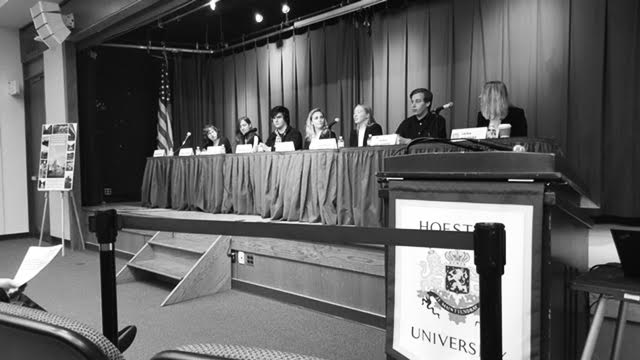Hofstra University co-celebrated its Dutch ancestry with the University of Amsterdam in a symposium titled, “New Netherland, New Amsterdam: A Celebration of Dutch Heritage and Transatlantic Exchanges.” The day-long discussion on Wednesday, Oct. 24, presented various events relating to Dutch culture and its influence in American life, including the keynote address by American Russell Shorto, author of “Amsterdam, Old and New: The Flow of Influence.”
The day began by recognizing the 25th anniversary of the Hofstra University and University of Amsterdam Exchange Program through a student experience panel with students from both universities.
The panel was moderated by Vera Kuipers, who had been part of the program in 2001. Kuipers has since gone on to become senior policy officer for the performing arts, film, literature, press and cultural affairs department of the Consulate-General of the Kingdom of the Netherlands.
“Based on [Shorto’s] amazing book, ‘The Island at the Center of the World: The Epic Story of Dutch Manhattan and the Founding Colony that Shaped America,’ and the vast research done by the New Netherland Institute and Research Center in Albany, New York that together provide a very new understanding of the origins of New York City,” said Neil Donahue, vice provost for Undergraduate Academic Affairs and Internationalization.
In his address, Shorto pointed to numerous inheritances, large and small, that Americans gained from the Dutch, like Santa Claus or “Sinterklaas,” the Dutch word, “cookie,” cole slaw and the Dutch word “baas,” in relation to a master-apprentice relationship evolving into the modern-day English word, “boss.”
Alexander Slovensky, a freshman anthropology and history major, is in a class called The Dutch Through History, which studies another of Shorto’s books, ‘Amsterdam: A History of the World’s Most Liberal City (2013)’. He found information from the book he had read embedded in the discussion, which he enjoyed. “I really liked [Shorto’s address] … I thought it was really informative,” he said.
Shorto argued that all of these little Dutch influences point to two big influences. These are, “the Dutch approach to free trade and the Dutch approach to tolerance. In New Amsterdam in the 1640s, there were reported to be 18 languages being spoken, and there were maybe only 500 or so people then, so New York was New York even before it was New York.”
Shorto also highlighted the Dutch’s ability to manipulate their land in advantageous ways.
“They began using the land to graze cattle and grow crops, and they got wealthy, and when they did, they realized they could make life better for their children than it had been for them; it kind of flipped a switch in the Dutch mentality that made them different from other Europeans. It made them innovators,” Shorto said.
Other subjects of the symposium included conversations about domestic life in Holland and ongoing research at the New Netherland Institute.
The symposium was sponsored by the Hofstra Cultural Center, the Office of the Provost and Senior Vice President for Academic Affairs, Hofstra College of Liberal Arts and Sciences, Hofstra University Honors College, the departments of history, fine arts, design and art history, Hofstra Chapter of Phi Beta Kappa Honor Society and the University of Amsterdam Office of International Student Affairs.
“As a Dutch student, it was interesting to hear more about the connection between New York currently and the Dutch culture,” said Eva Hamann, a graduate business and marketing student. “I never really realized how deep the Dutch culture is embedded into New York.”








